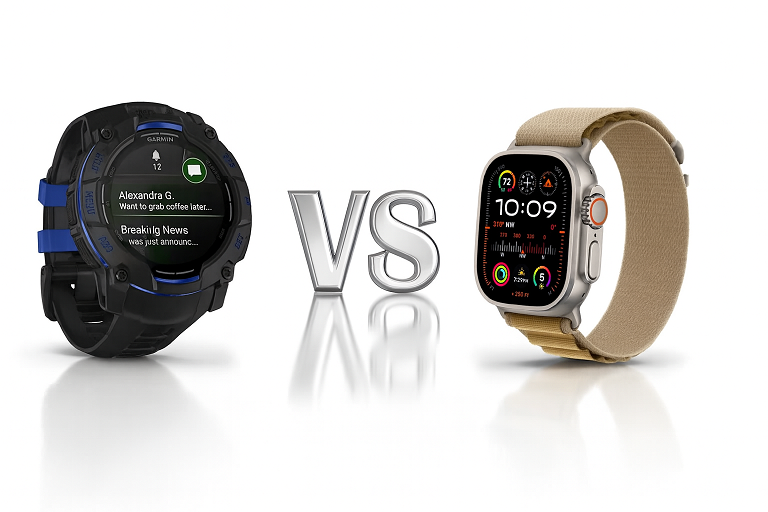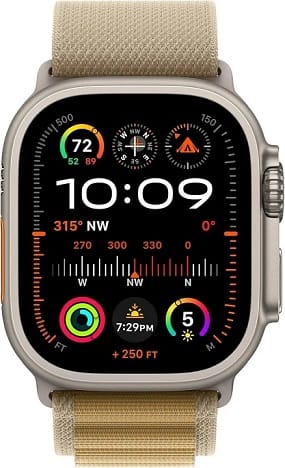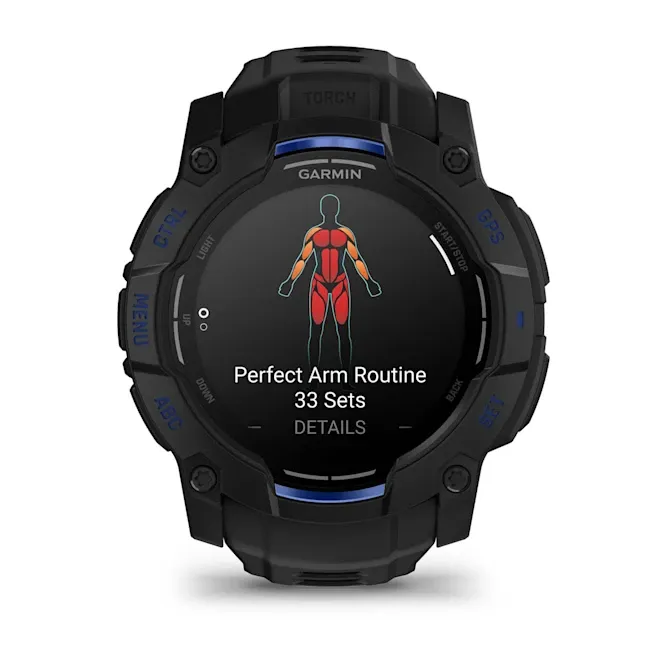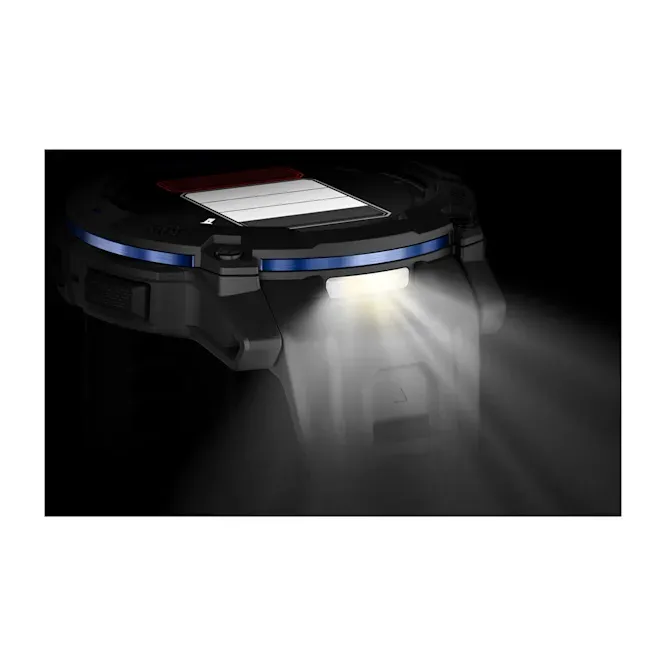Apple Watch Ultra 2 vs. Garmin Instinct 3: Rugged Adventure Smartwatches for 2025

Smartwatches have evolved far beyond glorified phone accessories. The Apple Watch Ultra 2 and the Garmin Instinct 3 are proof of this transformation; both watches are designed to withstand harsh environments while providing detailed health metrics, precise navigation and smartphone‑like intelligence. Yet the two take very different approaches. Apple prioritizes a premium, feature‑rich experience while Garmin focuses on battery life and outdoor durability. This deep dive compares design, display, battery life, sport and health tools, smart features, safety functions and value to help you decide which flagship rugged smartwatch makes sense for your adventures in 2025.
Design & Build Quality
Both watches are purpose‑built for the outdoors. The Apple Watch Ultra 2 uses a 49 mm titanium case with a flat sapphire crystal display that’s designed to resist scratches. Apple says the watch is water resistant to 100 m and is certified to MIL‑STD‑810H, meaning it has been tested against extreme temperatures, shock and vibration. The Ultra 2 is compatible with a huge ecosystem of bands, and its weight (61 g without band) feels hefty but premium on the wrist.
Garmin splits the Instinct 3 line into AMOLED and Solar (MIP) models. The Solar versions retain the series’ monochrome memory‑in‑pixel display and still look like rugged field instruments. Both models add a metal bezel ring and integrated LED flashlight (with white and red modes), giving them a more rugged aesthetic. The watches are built from fiber‑reinforced polymer with chemically strengthened glass on the Solar models and Gorilla Glass on the AMOLED models. They also meet U.S. military 810 standards and have 10 ATM (100 m) water‑resistance, making them suited for diving and high‑impact sports. Weight varies from 42 g to 53 g depending on size and display type—lighter than Apple’s Ultra 2.
Display & User Experience
Apple’s approach to the display is unapologetically lavish. The Ultra 2 features a 49 mm Always‑On Retina LTPO OLED panel with up to 3,000 nits brightness and a 1‑nit minimum. This range means the screen remains visible in direct sunlight yet dims to almost nothing at night. It shows rich colours and smooth animations thanks to Apple’s optimized watchOS. Interacting with the watch is seamless: the touchscreen is responsive, and the Action Button adds a reliable physical control for workouts or turning on the 86 db siren.
Garmin takes a different path. The AMOLED Instinct 3 uses colourful displays measuring 1.2 inch (45 mm) or 1.3 inch (50 mm), while the Solar edition sticks with a monochrome screen for maximum efficiency. The AMOLED screen looks vibrant indoors but is less bright than Apple’s OLED; it also drains the battery faster. The Solar model’s monochrome screen lacks touch input but is extremely readable in sunlight and enables very long battery life. Users navigate via five physical buttons; menu animations are less polished than watchOS, but the interface is functional even with gloves on—a plus for mountaineers.

Battery Life
Battery endurance is where these watches diverge most dramatically. Apple built the Ultra 2 with a built‑in rechargeable lithium‑ion battery rated for up to 36 hours of normal use and up to 72 hours in Low Power mode. Real‑world testing by Tom’s Guide found roughly 36 hours of everyday use or 12 hours with continuous GPS, though Apple’s low‑power setting can extend this to 72 hours. Fast charging replenishes 80 % of the battery in about an hour, so daily top‑ups are workable.
Garmin’s Instinct 3 is built for weeks away from an outlet. According to TechRadar, the 45 mm Instinct 3 (AMOLED) delivers up to 18 days of battery life in smartwatch mode, while the 50 mm model reaches 24 days. Enabling battery‑saver modes can boost life to 30 days, and the GPS‑only modes deliver up to 40 hours. Tom’s Guide notes that the Solar models can last forever with enough sunlight—roughly three hours of bright light per day - and are rated for 100+ hours of GPS tracking in Max Battery mode. Even the AMOLED versions achieve 68–86 hours of GPS tracking with power‑saving settings. These numbers dwarf the Ultra 2’s endurance and mean you could do multi‑day expeditions without recharging.
Verdict on battery
If you want the longest possible battery life—and especially if you’re drawn to solar charging—the Garmin Instinct 3 is the obvious winner. The Apple Watch Ultra 2 has the best battery life of any Apple Watch to date but still requires frequent charges. Fast charging mitigates this, but travellers or thru‑hikers will appreciate Garmin’s multi‑week endurance.
Sport & Fitness Features
Outdoor sport tracking
Both watches support a huge range of sports, but Garmin offers more depth for outdoor adventures. The Instinct 3 tracks everything from hiking, trail running, skiing, surfing and hunting to more niche activities like snowshoeing and horseback riding. Multi‑band GPS ensures reliable positioning in challenging environments, and ABC sensors (altimeter, barometer, compass) provide elevation and weather info. Garmin’s new features include multi‑band GNSS with SatIQ, training load and recovery metrics, sleep coach, nap detection, and muscle maps for strength workouts. Users also get a Body Battery energy monitor to assess their readiness for exertion.
Apple’s workout support is broad but less specialized. The Ultra 2 supports running, cycling, swimming, multisport workouts, automatic track detection, customizable workout views, precision start, race routes, pacer and a host of strength, yoga and HIIT modes. The watch includes on‑device compass features, waypoints and Backtrack for returning to your start point, plus offline topographic maps for U.S. national parks. However, it lacks some of Garmin’s training metrics like Body Battery and Training Readiness. Tom’s Guide points out that Garmin provides more nuanced data for activities with lots of elevation change, such as skiing and mountain biking, and its training and recovery tools are more extensive.
Health tracking
The Ultra 2 excels in health monitoring. It offers ECG (electrocardiogram) readings, blood oxygen monitoring, menstrual and cycle tracking, sleep apnea detection and heart‑rate zones. Apple’s Double Tap gesture allows users to control the watch with one hand, and watchOS integrates deeply with Apple’s Health and Fitness + services. The Ultra 2 also monitors environmental factors like noise levels and provides Crash Detection and Fall Detection.
Garmin’s Instinct 3 covers the basics—heart rate, blood oxygen saturation, stress monitoring and sleep tracking—but lacks ECG and menstrual tracking. It compensates with Body Battery, Training Readiness, Sleep Coach and detailed recovery metrics. Garmin’s health platform also integrates with Strava, TrainingPeaks and other endurance‑sport ecosystems.

Accuracy & insights
Real‑world testing by Tom’s Guide found that Apple’s elevation and distance metrics sometimes read higher than Garmin’s and Strava’s; during a 3.5‑mile hike, the Ultra 2 measured 1,578 ft of elevation gain versus 1,518 ft on the Instinct 3 and 1,477 ft on Strava. Apple’s heart‑rate readings were roughly 10 bpm higher than Garmin’s during intense efforts. While both devices offer reliable GPS accuracy thanks to dual‑band GNSS, these discrepancies highlight differences in sensor algorithms.
Smart Features & Connectivity
Apple is still the undisputed leader in smartwatch intelligence. The Ultra 2 runs watchOS 11 and offers a vast app ecosystem, on‑wrist message replies and cellular connectivity for calling or streaming music without an iPhone. The watch includes on‑wrist translations, global tide tracking, AI‑generated notification summaries and thousands of third‑party apps. Users can store music locally, pay via Apple Pay and even control their smart home through HomeKit.
Garmin’s Instinct 3 focuses on utility rather than apps. It supports Garmin Pay, message notifications and basic music controls, but lacks a touch screen and has no offline music storage. The ConnectIQ app store offers a limited selection compared with Apple, and the absence of third‑party apps like Spotify on the Instinct 3 is notable. Still, the watch includes SatIQ (auto‑selecting the most efficient GPS mode), multi‑band GPS and Bluetooth for pairing with sensors; but there’s no cellular connectivity.
Navigation & safety tools
Both watches include safety features, but they are implemented differently. Apple’s Ultra 2 offers Emergency SOS, international emergency calling, Crash Detection, Fall Detection, Backtrack and an 86 db siren for attracting attention. Offline maps with turn‑by‑turn directions and topographic details for U.S. national parks make the Ultra 2 a capable backcountry navigator. Apple’s Check In feature also lets you share your location and status with friends.
Garmin’s Instinct 3 has incident detection, LiveTrack and TracBack, which guides you back to your starting point. It includes a built‑in LED flashlight with red and white modes for signalling or illuminating your path. However, the watch does not support offline map downloads, so you’ll need to rely on breadcrumb trails and compass navigation. For many adventurers, Garmin’s safety tools are sufficient, but map lovers may miss Apple’s detailed cartography.

Price & Value
Apple sells the Ultra 2 at a premium price (around $799 at launch), which has remained relatively steady. With its titanium case, high‑resolution display, advanced health sensors, deep integration with the Apple ecosystem and cellular option, the price is justifiable for those seeking a do‑it‑all premium smartwatch. However, the cost could be prohibitive for people who primarily need a long‑lasting sports watch.
Garmin positions the Instinct 3 more aggressively. The AMOLED models cost $449–$499, while the Solar editions run $399–$449. These prices undercut Apple significantly. Tom’s Guide notes that the Instinct 3 delivers most of the features of Garmin’s top‑tier Fenix 8 series—minus offline mapping and music storage—for less than half the price. A cheaper Instinct E variant also exists, though it lacks multi‑band GPS, NFC and the flashlight.
Who Should Buy Which?
Choose the Garmin Instinct 3 if:
- Battery life is your top priority. The Instinct 3 can last weeks on a charge and even indefinitely in solar mode.
- You spend most of your time outdoors. Garmin’s rugged build, flashlight, multi‑band GPS, and comprehensive training and recovery tools cater to hikers, climbers and endurance athletes.
- You need simple but reliable smart features. If you’re fine with basic notifications and Garmin Pay and don’t require a full app ecosystem, the Instinct 3 fits the bill.
- You value affordability. Starting at $399, the Instinct 3 offers strong value and more choice in sizes and display types.
Choose the Apple Watch Ultra 2 if:
- You want a premium smartwatch with rich features and a smooth interface. The Ultra 2’s brilliant OLED display, extensive third‑party app support and watchOS perks make it feel like a tiny iPhone on your wrist.
- Health monitoring matters. Apple’s ECG, blood oxygen, sleep apnea detection and crash/fall detection provide medical‑grade features that Garmin lacks.
- Navigation and maps are important. Offline topographic maps and turn‑by‑turn directions give the Ultra 2 a clear advantage when exploring unknown trails.
- You live in the Apple ecosystem. Owning an iPhone unlocks features like message replies, on‑wrist translation, Apple Pay, Siri, HomeKit control and the new Double Tap gesture.
Final Thoughts
The Apple Watch Ultra 2 and Garmin Instinct 3 both deserve their rugged reputations, yet they serve different audiences. The Ultra 2 is a luxury adventure companion that transitions seamlessly from a mountain trail to a boardroom meeting, delivering polished software, high‑end health features and a superb display. The Instinct 3, on the other hand, is a no‑nonsense tool built for unplugged exploration, with battery life measured in weeks, a sturdy polymer case, and training metrics that rival Garmin’s pricier Fenix line. If you prioritise endurance and cost, the Instinct 3 is the go‑to. If you want premium smart features and are willing to charge more often, the Ultra 2 remains unmatched.
Looking ahead to 2025 and beyond, the competition among rugged smartwatches will likely intensify. Garmin’s upcoming Fenix 8 and Apple’s inevitable Ultra 3 will push boundaries further. For now, adventurers and outdoor athletes can rest easy knowing there’s a perfect watch for their needs—whether they favour Apple’s sleek luxury or Garmin’s long‑lasting grit.